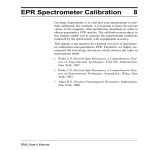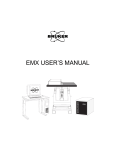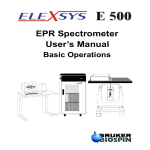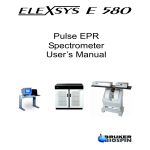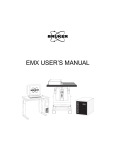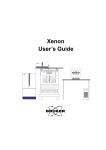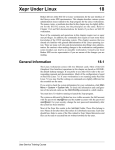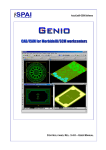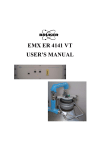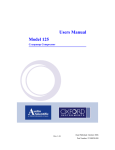Download Spectrometer Calibration
Transcript
EPR Spectrometer Calibration 17 For many experiments, it is vital that your spectrometer is carefully calibrated. For example, it is essential to know the precise values of the magnetic field modulation amplitude in order to obtain quantitative EPR spectra. The calibration procedures in this chapter enable you to measure the experimental conditions produced by the spectrometer with considerable accuracy. This chapter is not meant to be a general overview of spectrometer calibration and quantitative EPR. Therefore, we highly recommend the following references which discuss the topic in much greater detail: • Poole, C.P. Electron Spin Resonance, a Comprehensive Treatise on Experimental Techniques: First Ed., Interscience, New York, 1967. • Poole, C.P. Electron Spin Resonance, a Comprehensive Treatise on Experimental Techniques: Second Ed., Wiley, New York, 1983. • Alger, R.S. Electron Paramagnetic Resonance: Interscience, New York, 1968. User Service Training Course Standard Samples Standard Samples 17.1 Standard samples are useful for system performance tests, spectrometer calibration, and quantitative concentration measurements. Ideally the standard sample should contain stable, long lived paramagnetic species, be easily prepared under consistent and controlled methods, and should be fully characterized with respect to all spectroscopic parameters such as relaxation times and hyperfine and fine structure splittings. In addition, the resonance line should be narrow and preferably homogeneous. Unfortunately, the universal standard sample has not been found. Many standards have been suggested and each has its own particular merit. The standard samples supplied with every Bruker spectrometer are discussed below. DPPH (α, α‘ - diphenyl-ß-picryl hydrazyl) DPPH exhibits g-anisotropy, i.e. the g-value depends on the orientation of the sample with respect to the magnetic field. 17.1.1 DPPH serves as a reference both in the solid state and in the liquid state when dissolved in benzene or toluene/mineral oil. The line width measured from the solid is subject to exchange narrowing and thus, varies from under 1 gauss to over 4 gauss, depending on the solvent that was used for recrystallization. It has a g factor of 2.0036 ± 0.0003. When dissolved in solution, a quintet with unresolved hyperfine couplings is observed because the spin exchange narrowing is reduced as the sample is diluted. A small single crystal of DPPH is an ideal sample for calibrating the phase and the field modulation amplitude of the signal channel of an EPR spectrometer. DPPH has been studied extensively by: • Möbius, K. and R. Biehl. Multiple Electron Resonance Spectroscopy: Plenum Press, 1979. • Dalal, N.S., D.E. Kennedy, and C.A. McDowell. J. Chem. Phys.: 59, 3403 (1979). • Hyde, H.S., R.C. Sweed, Jr., and G.H. Rist. J. Chem. Phys.: 51, 1404 (1969). • Dalal, N.S., D.E. Kennedy, and C.A. McDowell. J. Chem. Phys.: 61, 1989 (1974). • Dalal, N.S., D.E.Kennedy, and C.A. McDowell. Chem. Phys. Lett.: 30, 186 (1975). Weak and Strong Pitch Samples 17.1.2 Pitch in KCl has emerged as a standard because of its long-lived paramagnetic radicals and low dielectric loss. Because of the long life of the radicals, it is unsurpassed as a test of spectrometer sensitivity. The pitch is added to a powder of KCl and the mixture is carefully mechanically mixed to obtain a homogeneous sample. After mixing, the sample is heated, pumped, and sealed under vacuum. Pitch is generally prepared in two concentrations: strong pitch which is 0.11% pitch in KCl, and weak pitch which is 0.0003% pitch in KCl. To correct for variations in spin concentration, each weak pitch sample is compared to a “standard” and assigned a correction factor. The peak to peak 17-2 Theory of Signal Channel Calibration line width is typically 1.7 G with a g-factor of 2.0028. The size (very weak) of the signal renders pitch ill suited for modulation amplitude calibration. The weak pitch samples from Bruker Biospin have an estimated concentration of 1013 spins per centimeter. The samples are calibrated and the correction factor is printed on the side of the tube. This sample is prepared for the purpose of measuring instrument performance owing to its high stability, however, it is not meant as a quantitative spin-counting standard. Theory of Signal Channel Calibration 17.2 You need to carefully calibrate your spectrometer’s signal channel reference phase and modulation amplitude in order to obtain maximum sensitivity, minimum distortion, and quantitatively reproducible measurements. The SCT/H and SCT/L signal channels in conjunction with the Xepr or WIN-ACQ software make this calibration easy to perform. The results of the calibration are saved on disk for future use. We recommend recalibration at least once a year to ensure quantitative and reproducible results. Each cavity or resonator has its own individual calibration file, therefore, this procedure must be followed for each cavity. Introduction 17.2.1 Calibration of the signal channel involves two separate yet interdependent procedures. The first procedure is to calibrate the peak to peak modulation amplitude. For the sake of brevity, modulation amplitude will be used in place of peak to peak modulation amplitude. The second procedure is to calibrate the phase difference between the reference signal and the modulated EPR signal. Because the calibration and adjustment of the modulation amplitude can affect the phase difference, the first procedure is performed first. Amplitude Calibration 17.2.2 You calibrate the modulation amplitude by overmodulating a narrow EPR signal. A crystal of DPPH, with a line width of approximately 1 G, is a very good sample to use. When the modulation amplitude is large compared to the line width, the magnetic field modulation brings the sample into resonance before and after the magnet has reached the field for resonance. This results in a broadening and distortion of the EPR signal. (See Figure 17-1.) In the limit of an infinitesimally narrow EPR signal, the peak to peak width of the first derivative EPR signal will be approximately equal to the peak to peak modulation amplitude. User Service Training Course 17-3 Theory of Signal Channel Calibration Figure 17-1 The signal shape of the DPPH EPR signal as a function of the field modulation amplitude. The first step of calibrating the modulation amplitude involves choosing the correct tuning capacitors. The modulation amplifier needs a bit of help to obtain large modulation amplitudes at modulation frequencies greater than 50 kHz. This is a consequence of the decreasing skin depth with increasing frequency. The modulation coils on the cavity are tuned, or made resonant, by adding a tuning capacitor in series with the modulation coil. Tuning Capacitor Figure 17-2 Modulation Coil The LC resonant circuit for high frequencies. The calibration routine switches various tuning capacitors in and out of the circuit until the modulation amplitude is maximized. The optimal capacitor for that particular frequency as well as the modulation amplitude for full gain of the modulation amplifier are recorded and saved with the calibration file. Once this data is available, the signal channel will then vary the input signal to the modulation amplifier to produce the modulation amplitude that you have selected. Those familiar with older EPR spectrometers will remember the tuning boxes for tuning the modulation coils. The above mentioned software and hardware makes these tuning boxes unnecessary as well as adding great flexibility in the choice of modulation frequencies. 17-4 Theory of Signal Channel Calibration Phase Calibration 17.2.3 Once the modulation amplitude has been calibrated, the reference phase is easily calibrated by studying the phase angle dependence of the signal intensity. The intensity of the output signal is proportional to the cosine of the phase difference between the reference signal and the modulated EPR signal. (See Figure 17-3.) It is most convenient to determine where the 90° phase difference occurs because first, the absence of a signal (cos(90°) = 0) is easy to detect and second, the cosine function (and hence the intensity) changes rapidly with respect to the phase angle at 90°. In the calibration routine, spectra are acquired at several different values of the reference phase and the 90° phase difference is extrapolated from the signal intensities. The phase angle resulting in maximum signal intensity for that particular frequency is recorded and saved with the calibration file. The phase difference between the modulated EPR signal and the reference signal depends on several experimental conditions. The length of the cable leading to the modulation coils, the inductance of the coils in the particular cavity, the gain setting of the modulation amplifier, the tuning capacitors, and the signal channel used can all change the phase difference. However, the reference phase calibration is performed automatically during the routine described in this section. The two editions of the book by C.P. Poole that are mentioned at the beginning of this chapter are very good references for the details on the theory of phase sensitive detection and the calibration of signal channels. We encourage you to explore this topic further to learn more about calibration. Figure 17-3 The signal intensity as a function of the reference phase angle. User Service Training Course 17-5 Calibrating the Signal Channel (Elexsys) Calibrating the Signal Channel (Elexsys) 1. Do not attempt to calibrate a cavity with an E R 4 11 2 H V o r E R 4113HV helium cryostat installed in the cavity. The cryostat sample holder prevents the DPPH sample from being centered properly. 17.3 Get ready for the calibration routine. Follow the instructions of Section 3.1 and 3.2 of the Elexsys E 500 User’s Manual: Basic Operations. You should have the spectrometer turned on, the cavity properly installed with a Bruker standard DPPH sample in it, and the microwave bridge and cavity tuned. Remove cryostats from the cavity because it is easier to position the DPPH sample properly in the cavity. (Except for the FlexLine resonators: it is necessary to use the ER 4118CF cryostat when calibrating FlexLine resonators.) Another advantage is that the resonant frequency of the cavity will be approximately 9.8 GHz without the helium cryostat and the field for the DPPH signal will be known (approximately 3500 Gauss). The DPPH sample is a point sample so it is important to have it roughly centered in the cavity. The sample has a mark on it indicating where the DPPH is. The distance from the collet to the center of the cavity is approximately 70 mm. 70 mm Figure 17-4 2. 17-6 The approximate distance from the collet to the center of the cavity. Create a calibration experiment. Click the New Experiment button in the monitoring panel and the dialog box will appear. (See Figure 17-5.) Enter a name for the experiment (calibration for example) in the Experiment Name column. Click the Calib tab. Make sure the Standard push button is activated (green). The R.F. button is for ENDOR calibration. Click the Create button to close the dialog box. Calibrating the Signal Channel (Elexsys) Create an Experiment Click Create Figure 17-5 3. Select Calibration Creating a calibration experiment. Open the parameter dialog box. Click the Parameter button to open the Calibration Parameters dialog box. If the Calibration folder is not in front, click its tab to bring it to the front. (See Figure 17-6.) Set Frequency Range Parameter Button Tuning Caps Search Amplitude Search Phase Search Figure 17-6 The Calibration Parameters dialog box. User Service Training Course 17-7 Calibrating the Signal Channel (Elexsys) 4. Set the calibration frequency range. A calibration is required for each modulation frequency that you intend to use. The SCT/H signal channel, has a range of 100 kHz to 6 kHz in 0.1 kHz steps. The SCT/L signal channel covers the frequency range of 6 kHz to 100 Hz in 1 Hz steps. Most people will normally run all their spectra using 100 kHz modulation, but under some special circumstances, other frequencies may be desirable. A good approach to take is to calibrate the signal channel every 10 kHz from 100 kHz to 10 kHz. A sufficiently large range of frequencies is then covered for most EPR experiments. Enter the Mod. Frequency Start [kHz] (usually 100 kHz), Mod. Frequency End [kHz] as well as the Mod. Frequency Increment [kHz] values. The start value must be greater than the end value. (See Figure 17-6.) Note that you should set the start and end values equal to each other for ER 4122SHQE or ER 4119HS cavities so that only one frequencies at a time is calibrated. (See the warning in the lefthand margin.) 5. Set initial values for the tuning caps search. The parameters in this section set the starting values for the tuning capacitor search. (See Figure 17-6.) The Initial Modulation Amplitude defines the modulation amplitude used when optimizing the tuning capacitors. The default value, 10%, is appropriate for most cavities and resonators. The default Initial Sweep Width of 20 G works well for a DPPH sample. If you know an approximate optimal value for the tuning capacitors at 100 kHz, you can enter that value in Tuning C Start Value. This will save you time because otherwise the searching routine will start from 0 nF. Mod Frequency Limit is always set at 50 kHz because skin depth poses less of a problem at lower frequencies. 6. Adjust the Mod. Amplitude Limit. The Mod. Amplitude Limit parameter limits the size of the signal sent to the modulation amplifier. This prevents damage to the coils owing to excessive current. Enter a value of 75% for an ER 4122 SHQ cavity. For Flex-line resonators, a value of 10% is more appropriate. A value of 30% works well for ER 4122SHQE and ER 4119HS cavities. 40% is appropriate for most of the other cavities. It is always safe to set this value a bit low as you will adjust this value later. A 100 G Sweep Width is sufficient for most resonators. (See Figure 17-6.) The EN 801 ENDOR resonator should not be used above 25 kHz. Consult the Elexsys E 560 documentation for instructions on calibrating this cavity. T h e E R 4 12 2 S H Q E and ER 4119HS resonators should only be calibrated one modulation frequency at a time! At lower modulation frequencies, the modulation amplitude can get sufficiently large to damage the coils. The Mod. Amplitude Limit needs to be adjusted separately for each modulation frequency. It is not necessary to calibrate every 100 Hz from 100 kHz to 10 k H z . I n p a r t i c u l a r, FlexLine resonators in a cryostat with no gas flow can become sufficiently warm to damage the resonator if you calibrate more than 20 frequencies in one experiment. 17-8 Calibrating the Signal Channel (Elexsys) Better safe than sorry. It is a good idea to calibrate the phase of the second harmonic when running the calibration routine. 7. Enter values for the modulation phase search. The parameters in this step depend on your calibration sample. The default values of 1 G Sample Line Width and 20 G Sweep Width work well with the Bruker DPPH standard. The signal channel can produce either a first harmonic (first derivative) or a second harmonic (second derivative) spectrum. If you have no need for second harmonic spectra and wish to save a bit of time in the calibration routine, you may deselect this option by clicking the Calibrate 2nd Harmonic button. The green color indicates that the option is selected. (See Figure 17-6.) 8. Enter the filename for the calibration file. Click the Results tab. (See Figure 17-7.) The calibration file name usually consists of two to four letters that identify the type of cavity (ST for ER 4102ST or SHQE for ER 4122SHQE) followed by the serial number of the cavity. This number is found on the back or front of the cavity. For FlexLine series resonators the serial number is found at the top part of the module block. Enter the calibration file name into the Calibration Data Set box. If you are re-calibrating, you can click the file name in the drop down list of the Calibration Data Set. The new values will be appended to the calibration file or replace previous values in the file. If you want to start fresh, click the Delete Data Set button to delete the old calibration data. Select Resonator Calibration File Name Delete Data Set Button High Pass Filter AFC Trap Filter Setup Scan Figure 17-7 The Results folder of the Calibration Parameters dialog box. User Service Training Course 17-9 Calibrating the Signal Channel (Elexsys) The ER 4105DR dual cavity is different from the ER 4116DM dual m o d e c a v i t y. T h e ER 4116DM has only one set of modulation coils. 9. Select the resonator. In almost all cases, the 1st Resonator should be selected. (See Figure 17-7.) The ER 4105DR dual cavity has two sets of modulation coils. By selecting 1st Resonator or 2nd Resonator, you are selecting the set of modulation coils that are to be calibrated. 10. Turn on the AFC Trap and High Pass Filters. The AFC trap filter blocks any signal components at the AFC modulation frequency that may contribute to noise in the EPR signal. The high pass filter suppresses low frequency signal components that also contribute to added noise in the EPR signal. These two filters influence the calibration values of the signal channel. By default they are both selected. Ensure that both options are selected. (See Figure 17-7.) Only under very rare circumstances would you acquire spectra without these filters. 11. Start the Setup Scan. When the Setup Scan function is activated, the magnetic field is swept rapidly (up to 50 Gauss at about a 30 Hz rate) to provide a “real time” display of the EPR spectrum on the screen. Click the Setup Scan button in the Results folder. (See Figure 17-7.) Activate Button Setup Scan Button Figure 17-8 Setup Scan Time Constant The Setup Scan window. A Setup Scan window will appear. Click the Activate button in the monitoring panel if it is not already activated. Then click the Setup Scan button in the Setup Scan window to activate it. (See Figure 17-8.) Leave this window open so you can adjust the parameters interactively. 17-10 Calibrating the Signal Channel (Elexsys) 12. Figure 17-9 Set the Microwave Attenuator to approximately 25 dB. Click the Microwave tab. Set the microwave power to 25 dB. (See Figure 17-9.) The Microwave folder of the Calibration Parameter dialog box. 13. You should be able to see the DPPH signal by now. If you do not see the signal, change the modulation phase by 90 degree. If you still can not find the signal, refer to Chapter 8 of the Elexsys E 500 User ’s Manual: Basic Operations Center your DPPH spectrum in the display. Click the Absc.1: Field tab. (See Figure 17-10.) Arrange the Calibration Parameters window and the Setup Scan dialog box so that you can see both of them at the same time. Make sure that the Center box is selected (green). Adjust the Center Field value by entering a field value or clicking on the up and down arrows until the signal appears centered in the Setup Scan window. For a microwave frequency of about 9.8 GHz, DPPH resonates at 3500 Gauss. Reducing the Sweep Width in the Setup Scan window can help you to center the signal. Figure 17-10 The Absc.1: Field folder of the Calibration Parameters dialog box. 14. The EN 801 ENDOR resonator should not be used above 25 kHz. Consult the Elexsys E 560 documentation for instructions on calibrating this cavity. Adjust other parameters. Adjust the Receiver Gain so that the signal fills approximately half of the vertical display range in the Setup Scan window. Make sure that the signal channel is set to 100 kHz modulation (or the maximum modulation frequency you entered in the Calibration folder) and first harmonic detection. A 1 gauss Modulation Amplitude usually is sufficient. User Service Training Course 17-11 Calibrating the Signal Channel (Elexsys) 15. Optimize the DPPH sample position. Move the sample tube up and down until the maximum signal intensity is attained. (See Figure 17-11.) Avoid moving the sample from side to side. Perhaps the best technique is to loosen the collet nuts for the pedestal and sample tube and move the sample too low. Then use the pedestal to slowly push the sample up. Sometimes the process of moving the sample tube in the cavity can cause the AFC to lose lock. Re-tune the frequency if this happens. If the signal is clipped, decrease the Receiver Gain. Rotate the sample tube until the maximum signal intensity is attained. When you have maximized the signal intensity, secure the sample tube by tightening the collet nuts. Check the matching if needed. You may need to re-center the signal by adjusting the Center Field in the Absc.1: Field tab. DPPH Sample Figure 17-11 Fine adjustment of the DPPH sample height in the cavity. 17-12 Calibrating the Signal Channel (Elexsys) 16. Close the Setup Scan window. Click the Close button in the Setup Scan window. 17. Reset some parameters. After centering the DPPH sample, most of the parameters should be fairly close to what is needed for the calibration routine. Set the Receiver Gain to approximately 36 dB. 18. Start the calibration routine. Click the Result tab. Move the Calibration Parameters window to the corner so that you can see the acquisition and the calibration result at the same time. Click the Run button in the monitoring panel to start the calibration routine. Stop Button Pause Button Run Button Figure 17-12 The Acquisition control buttons. 19. Adjust the Receiver Gain. Monitor the Receiver Level while the scan is running. (See Figure 17-13.) Receiver Level Meter Figure 17-13 Monitoring the Receiver Gain. If the needle deflects more than 1/4 of the display, stop the calibration routine by clicking the Run/Abort button. Lower the Receiver Gain and restart the calibration by clicking the Run button again. A warning message will appear asking if you want to overwrite the existing value. Click the Yes button to continue. Repeat until the needle does not deflect more than 1/4 of the display. You may have to repeat this last step a few times. User Service Training Course 17-13 Calibrating the Signal Channel (Elexsys) 20. Observe the calibration results. The Results folder consists of a table of parameter values and settings for each modulation frequency. The first column is the modulation frequency. For modulation frequencies greater than or equal to 50 kHz, the optimal tuning capacitor value is listed in the second column. The third column contains the value of Mod Amp [% max]. Mod Amp [G] in the fourth column is the measured maximum modulation amplitude when the corresponding Mod Amp [% max] is used. Phase #1 and Phase #2, in columns five and six respectively, are the phases at which the first and second harmonic signals are nulled. (See Figure 17-14.) Figure 17-14 The calibration results. 21. 17-14 Check the Mod. Amp [G] at 100 kHz. The calibration routine performs its task sequentially, starting with the highest modulation frequency and continuing for each selected modulation frequency. As each parameter is determined, it is displayed in the table. (See Figure 17-14.) Wait until the 100 kHz calibration is completed. Click the Pause button of the Acquisition Control buttons. Note the value in the fourth column of the table, Mod Amp [G]. Compare the Mod Amp [G] at 100 kHz with the values listed for your cavity in Table 17-1. If the value obtained by the calibration routine is slightly less than or approximately equal to the value listed in Table 17-1, allow the calibration routine to continue its task by clicking the Pause button again and proceed to Step 23. If the value exceeds the values listed in Table 17-1, stop the calibration routine by clicking the Run/Abort button in the Acquisition Control buttons. Values that are too high can allow excessive current to flow through the modulation coils of the cavity at the maximum modulation amplitude, resulting in damaged modulation coils. Calibrating the Signal Channel (Elexsys) Cavity Maximum Mod. / Gauss at 100 kHz ER 4102ST 32 ER 4105DR 32 ER 4104OR 32 ER 4116DM 10 ER 4103TM 16 ER 4108TMH 32 ER 4106ZRC 10 ER 4106ZRAC 10 ER 4107WZC 10 ER 4107WZAC 10 ER 4115ODC 10 ER 4115ODAC 10 ER 4119HS 25 ER 4122SHQ 15 ER 4122SHQE 25 ER 4114HT 7 ER 4117MX (or D-MVT) 10 ER 4117D-R 32 ER 4109EF 10 Table 17-1 Maximum modulation amplitude for EPR cavities. User Service Training Course 17-15 Calibrating the Signal Channel (Elexsys) 22. Reset the Mod. Amplitude Limit. The Mod. Amplitude Limit parameter which was set in Step 6. limits the size of the signal sent to the modulation amplifier to prevent any danger of burning out the modulation coils. To calculate a safer value for Mod. Amplitude Limit use the following formula: Max. Mod. Mod. Amp [G] Mod Amplitude Limit = Mod Amp[%max] ------------------------------------ where Mod Amp[%max] and Mod. Amp [G] are the values listed in the calibration table and Max. Mod. is the maximum modulation amplitude listed for your cavity in Table 17-1. Enter this new value for Mod. Amplitude Limit in the Calibration tab. Click the Results tab to bring it to the front. Click the Run button to restart the calibration routine. 17-16 23. Finish the calibration. When the routine is finished the Run button will no longer be highlighted and the calibration data for the lowest modulation frequency is completed. (I.e. the calibration data in the Results tab are no longer -1.) 24. Special Instructions for ER 4122SHQE and ER 4119HS cavities. It was mentioned on page 8 that these cavities should be calibrated one frequency at a time. An additional requirement is that the Mod. Amplitude Limit be set properly at each modulation frequency. Follow Step 21. and Step 22. for each of the individual modulation frequencies after you have started the calibration routine for that frequency. 25. Adding additional frequencies. If you wish to add more frequencies to the calibration file, for example lower frequencies below 10 kHz, the remaining instructions guide you through the necessary steps. Click the Calibration tab. Change the Mod. Frequency Incr. (for example, to 2 kHz). Change the Mod. Frequency Start (for example to 5 kHz). Change the Mod Frequency End (for example to 1 kHz). (See Figure 17-15.) For modulation frequencies less than 10 kHz you need to reset the Mod. Amplitude Limit to 10%. Calibrating the Signal Channel (Elexsys) Figure 17-15 Changing the Frequency Range. 26. Start the calibration routine. Click the Run button to start the calibration routine. The low modulation frequency calibration data will be appended to the table. If there is one or more calibration frequencies already existing in the previous calibration file, a warning message will appear on the screen asking you if you want to overwrite the existing value. Click the Yes or No button (depending on your wishes) to continue the calibration routine. Notice that the previous calibration data for other frequencies are still kept in the file. 27. Close the Calibration Parameters dialog box. Click the Close button in the Calibration Parameters dialog box. The signal channel is now calibrated for your cavity and the data saved in the calibration file. The next time when you connect the Xepr software to the spectrometer, this calibration file will be the default calibration file. User Service Training Course 17-17 Calibrating the Signal Channel (EMX) Calibrating the Signal Channel (EMX) 17.4 Preparing for Calibration 17.4.1 1. Do not attempt to calibrate a cavity with an E R 4 11 2 H V o r E R 4113HV helium cryostat installed in the cavity. Follow the instructions of Sections 3.2 through 3.5 of the EMX User’s Manual. You should have the spectrometer turned on, the cavity properly installed with a Bruker standard DPPH sample in it, and the microwave bridge and cavity tuned. Remove cryostats from the cavity because it is easier to position the DPPH sample properly in the cavity. (Except for the FlexLine resonators: it is necessary to use the ER 4118CF cryostat when calibrating FlexLine resonators.) In particular, the ER 4112HV and ER 4113HV helium cryostats prevent the correct positioning of the sample. Another advantage is that the resonant Collet Nut Fiduciary Mark Irradiation Grid Cover Pedestal Figure 17-16 Proper positioning of the DPPH sample. frequency of the cavity will be approximately 9.8 GHz without the helium cryostat and the field for the DPPH signal will be known (approximately 3480 Gauss). The DPPH sample is a small point sample and therefore has a fiduciary mark that indicates the position of the DPPH crystal in the sample tube. Center the DPPH sample vertically in the cavity. The center of the black irradiation grid cover corresponds approximately to the vertical center of the cavity. It is not possible to change the actual Sweep Width while the Set Up Scan is enabled. Change the Sweep Width before t he Set Up Scan i s enabled. 17-18 2. Open the Interactive Spectrometer Control dialog box. Click the Interactive Spectrometer Control button in the tool bar and the dialog box will appear. (See Figure 17-17.) We can now optimize some of the parameters and adjustments for the calibration routine. 3. Set some parameters. Set the Microwave Attenuator to approximately 25 dB. The Time Constant needs to be set to a low value (less than about 0.16 ms). A Modulation Amplitude of 1 Gauss is usually sufficient. Set the Sweep Width to 100 Gauss. A Receiver Gain of approximately 1 x 103 works well. Calibrating the Signal Channel (EMX) 4. Click the Enable button for the Set Up Scan. When this option is enabled, the magnetic field is swept rapidly (up to 50 Gauss) to provide a “real time” display of the EPR spectrum on the screen. 5. Center your DPPH spectrum in the display. Adjust the Field slider bar until the signal appears centered in the Setup Scan window. For a microwave frequency of about 9.78 GHz, DPPH resonates at 3480 Gauss. Adjust the Receiver Gain so that the signal fills approximately half of the vertical display range. Make sure that the signal channel is set to 100 kHz modulation and first harmonic detection. Magnetic Field Enable Button Figure 17-17 The Interactive Spectrometer Control dialog box. 6. Optimize the DPPH sample position. Move the sample tube up and down until the maximum signal intensity is attained. (See Figure 17-16.) Avoid moving the sample from side to side. Perhaps the best technique is to loosen the collet nuts for the pedestal and sample tube and move the sample too low. Then use the pedestal to slowly push the sample up. Sometimes the process of moving the sample tube in the cavity can cause the AFC to lose lock. Retune the frequency if this happens. If the signal is clipped, decrease the Receiver Gain. When you have centered the DPPH sample, secure the sample tube by tightening the collet nuts. User Service Training Course 17-19 Calibrating the Signal Channel (EMX) 7. If there is no spectrum available, click on the New Experiment button in the tool bar to create a new spectrum. (See Figure 17-18.) Transfer the parameters. To set the parameter values to a spectrum, click on the Set parameters to spectrum button. The cursor will turn into the letter P (for Parameter). Place the cursor on a spectrum window and click the left mouse button to copy the parameters to that spectrum. Click the Interactive Spectrometer Control button in the tool bar to close the dialog box. New Experiment Button Figure 17-18 The New Experiment button. 8. Check the AFC Trap and High Pass Filters. Click on the Signal Channel Options command in the Parameter drop-down menu. The Signal Channel Options dialog box will appear. Figure 17-19 The Signal Channel Options dialog box. The AFC trap filter blocks any frequency signal components at the AFC modulation frequency that may contribute to noise in the EPR signal. The high pass filter suppresses low frequency signal components that may also contribute to added noise in the EPR signal. These two filters influence the calibration values of the signal channel. By default they are both selected. Ensure that both options are checked. Only under very rare circumstances would you acquire spectra without these filters. 17-20 Calibrating the Signal Channel (EMX) 9. You do not need to edit the Static Field parameter for a signal channel calibration. Adjust some parameters. After centering the DPPH sample, most of the parameters should be fairly close to what is needed for the calibration routine. Check the values in the Standard Acquisition Parameter dialog box and modify them so that they correspond to the values in Figure 17-20. The Center Field value may be somewhat different from what is displayed in Figure 17-20, but the Sweep Width must be 100 Gauss. Figure 17-20 Parameters for a signal channel calibration. 10. Acquire a spectrum. Click the RUN button in the tool bar. 11. Adjust the Receiver Gain. Monitor the Receiver Level while the scan is running. (See Figure 17-21.) If the needle deflects more than 1/4 of the display, lower the Receiver Gain. Reacquire the spectrum and lower the Receiver Gain until the needle does not deflect more than 1/4 of the display. You may have to repeat this last step a few times. Receiver Level Figure 17-21 The Receiver Level display. User Service Training Course 17-21 Calibrating the Signal Channel (EMX) 12. Set the center field. To interactively set the center field, click the Interactive Change of Center Field Parameter button in the tool bar.(See Figure 17-22.) Interactive Change Button Figure 17-22 The Interactive Change of Center Field Parameter button in the Tool Bar. Clicking this button creates a marker (vertical line) in the spectrum window that moves with the cursor. Place the cursor where you would like the center field to be and click with the right mouse button. (See Figure 4-13 of the EMX User’s Manual.) This action replaces the center field value with the magnetic field position of the marker. For further details on this operation consult Section 4.3.2 of the EMX User’s Manual. Figure 17-23 The center field marker. Acquire the spectrum once more. The DPPH signal should now be nicely centered in the spectrum. 17-22 Calibrating the Signal Channel (EMX) Calibrating the Signal Channel 1. 17.4.2 Open the Calibrate Signal Channel dialog box. Click the Calibrate Signal Channel command in the Acquisition drop-down menu. A new dialog box will appear. Figure 17-24 The Calibrate Signal Channel dialog box. 2. Enter the filename for the calibration file. The calibration file name usually consists of two or three letters that identify the type of cavity (ST for ER 4102ST or TM for ER 4103TM) followed by the serial number of the cavity. This number is found on the back or front of the cavity. Click on the Change File button to open the Open Calibration File dialog box. Signal channel calibration files are normally stored in the tpu subdirectory along with field controller and other calibration files. Enter a filename and click OK. Figure 17-25 The Calibrate Signal Channel dialog box. User Service Training Course 17-23 Calibrating the Signal Channel (EMX) The ER 4119HS resonator should only be calibrated one modulation frequency at a time! At lower modulation frequencies, the modulation amplitude can get sufficiently large to damage the coils. The Mod. Amplitude Limit needs to be adjusted separately for each modulation frequency. Better safe than sorry. It is a good idea to calibrate the phase of the second harmonic when running the calibration routine. It is not necessary to calibrate every 100 Hz from 100 kHz to 10 k H z . I n p a r t i c u l a r, FlexLine resonators in a cryostat with no gas flow can become sufficiently warm to damage the resonator if you calibrate more than 20 frequencies in one experiment. 17-24 3. Set the frequency limits. A calibration is required for each modulation frequency that you intend to use. The standard signal channel, the EMX 027 SCT-H, has a range of 100 kHz to 6 kHz in 0.1 kHz steps. Most people will normally run all their spectra using 100 kHz modulation, but under some special circumstances, other frequencies may be desirable. A good approach to take is to calibrate the signal channel every 10 kHz from 100 kHz to 10 kHz. A sufficiently large range of frequencies is then covered for most EPR experiments.Note that you should set the start and end values equal to each other for the ER 4119HS cavity so that only one frequencies at a time is calibrated. (See the warning in the lefthand margin.) 4. Choose the harmonics. The signal channel can produce either a first harmonic (first derivative) or a second harmonic (second derivative) spectrum. If you have no need for second harmonic spectra and wish to save a bit of time in the calibration routine, you may deselect the option to calibrate the phase for the second harmonic by clicking the 2nd Harmonic box. A cross in the box indicates that the option is selected. However, the time-savings are minimal and you never know when you may need a second harmonic display: it is probably best to always calibrate the second harmonic phase. 5. Select the resonator. In almost all cases, the 1st Resonator should be selected. The ER 4105DR dual cavity has two sets of modulation coils. By selecting 1st Resonator or 2nd Resonator, you are selecting the set of modulation coils that are to be calibrated. 6. Adjust the Mod. Amplitude Limit. The Mod. Amplitude Limit parameter limits the size of the signal sent to the modulation amplifier. This prevents damage to the coils owing to excessive current. Enter a value of 75% for an ER 4122 SHQ cavity. For Flex-line resonators, a value of 10% is more appropriate. A value of 30% works well for ER 4122SHQE and ER 4119HS cavities. 40% is appropriate for most of the other cavities. It is always safe to set this value a bit low as you will adjust this value later. A 100 G Sweep Width is sufficient for most resonators. Calibrating the Signal Channel (EMX) 7. Start the calibration routine. Click the Start button. A new dialog box will appear. (See Figure 17-26.) The spectrometer will then automatically calibrate the signal channel at each of the specified modulation frequencies. The ER 4105DR dual cavity is different from the ER 4116DM dual m o d e c a v i t y. T h e ER 4116DM has only one set of modulation coils. Figure 17-26 The Calibration routine The calibration file consists of a table of parameter values and settings for each modulation frequency. The first parameter is the modulation frequency. The second column indicates the resonator that was selected in Step 5. For modulation frequencies greater than or equal to 50 kHz, the optimal tuning capacitor value is listed in the third column. The fourth column contains the value of Mod Amp [% max]. Mod Amp [G] in the fifth column is the measured maximum modulation amplitude when the corresponding Mod Amp [% max] is used. Phase #1 and Phase #2, in columns six and seven respectively, are the phases at which the first and second harmonic signals are nulled. 8. Check Mod. Amp [G] at 100 kHz. The calibration routine performs its task sequentially, starting with the highest modulation frequency and continuing for each selected modulation frequency. As each parameter is determined, it is displayed in the table. (See Figure 17-26.) Wait until the 100 kHz calibration is completed and note the value in the fifth column of the table, Mod Amp [G]. This value can allow excessive current to flow through the modulation coils of the cavity at the maximum modulation amplitude, resulting in damaged modulation coils. Compare the Mod Amp [G] at 100 kHz with the values listed for your cavity in Table 17-2. If the value obtained by the calibration routine exceeds the values listed in Table 17-2, first record the values for Mod Amp [G] and Mod Amp [%max] because you will need them for the next step. Then stop the calibration routine by clicking the STOP button in the Tool Bar twice. If the value is less than or equal to the value listed in Table 17-2, allow the calibration routine to continue its task and proceed to Step 11. User Service Training Course 17-25 Calibrating the Signal Channel (EMX) Cavity Maximum Mod. / Gauss at 100 kHz ER 4102ST 32 ER 4105DR 32 ER 4104OR 32 ER 4116DM 10 ER 4103TM 16 ER 4108TMH 32 ER 4106ZRC 10 ER 4106ZRAC 10 ER 4107WZC 10 ER 4107WZAC 10 ER 4115ODC 10 ER 4115ODAC 10 ER 4119HS 25 ER 4122SHQ 15 ER 4122SHQE 25 ER 4114HT 7 ER 4117MX (or D-MVT) 10 ER 4117D-R 32 ER 4109EF 10 Table 17-2 Maximum modulation amplitude for EPR cavities. 9. Set the Mod. Amplitude Limit. The Mod. Amplitude Limit parameter in the Calibrate Signal Channel dialog box allows you to limit the size of the signal sent to the modulation amplifier to prevent any danger of burning out the coils. To calculate a safer value for Mod. Amplitude Limit use the following formula: Max Mod Actual Mod Mod Amplitude Limit = Mod Amp[%max] ---------------------------- where Mod Amp[%max] is the value determined by the calibration routine, Actual Mod is the value for Mod. Amp [G] determined by the calibration routine, and Max Mod is the maximum modulation amplitude listed for your cavity in Table 17-2. Return to Step 1. (e.g. start the calibration routine again) and enter this new value for Mod. Amplitude Limit. Continue from Step 2. through Step 8. as before. 17-26 Calibrating the Signal Channel (EMX) 10. Special Instructions for ER 4119HS cavities. It was mentioned on page 24 that these cavities should be calibrated one frequency at a time. An additional requirement is that the Mod. Amplitude Limit be set properly at each modulation frequency. Follow Step 8. and Step 9. for each of the individual modulation frequencies after you have started the calibration routine for that frequency. 11. Finish the Calibration. When the routine is finished the message Acquisition Done! will appear in the info line. Double click the control menu box in the upper left hand corner of the window to close the window. The signal channel is now calibrated for your cavity and the data saved in the calibration file. The next time that you start the WIN-EPR Acquisition software, this calibration file will be the default calibration file. User Service Training Course 17-27 Notes 17-28




























